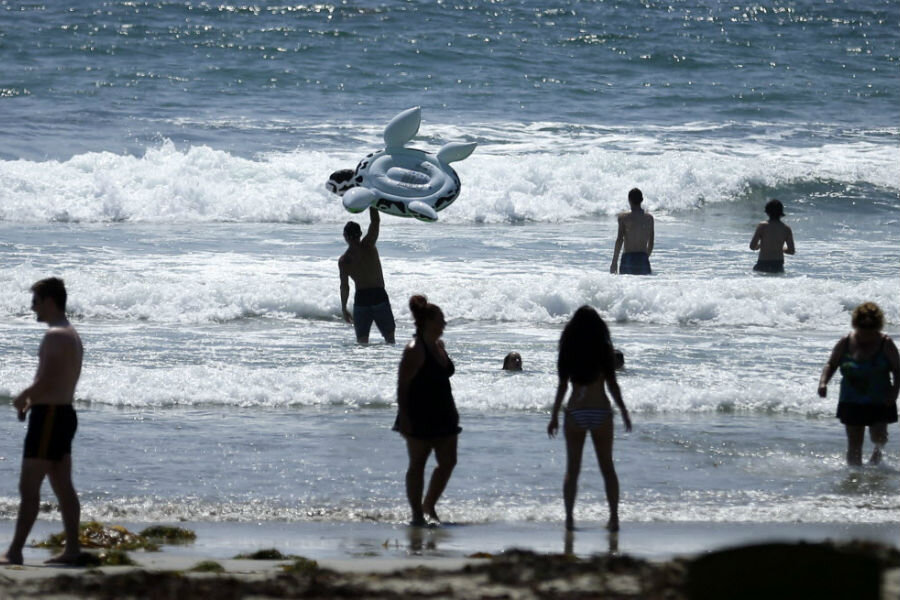1 in 10 beach water samples is contaminated, report finds
Loading...
Ten percent of all water samples taken from American beaches last summer exceeded the protective benchmark for swimmer safety established by the Environmental Protection Agency, according to a report released Wednesday.
Authors of the Natural Resources Defense Council's 24th annual guide to water quality at vacation beaches pointed to stormwater runoff as a particular long-term problem. But in the shorter term, they urge the EPA to finalize the proposed Clean Water Protection Rule, which would reaffirm that discharges of upstream water can be regulated under the Clean Water Act of 1972. [Editor's note: This paragraph originally identified the Natural Resource Defense Council incorrectly.]
“The rule restores protections that long existed in the Clean Water Act but that have been thrown into legal limbo by ... Supreme Court decisions” in 2001 and 2006, says Jon Devine, a senior attorney for the NRDC.
Specifically, the rule would clarify what kinds of water bodies fall under the jurisdiction of the Clean Water Act. It was proposed in March by the EPA and US Army Corps of Engineers.
The study was based on sampling conducted during the summer of 2013 at nearly 3,500 coastal and Great Lakes beaches in the United States. About 1 in 10 samples contained excessive levels of microscopic pathogens, industrial and agricultural chemicals, or sewage, the NRDC analysis reveals.
The report cites the Clean Water Protection Rule as “the greatest opportunity” to address discharge of pollutants into upstream waters that eventually flow into America’s beaches.
But in the longer term, the report stressed the importance of stormwater runoff, which washes over roads, buildings, parking lots, and lawns, where it picks up oil and grease, pesticides, and pollutants on its way to storm drains that empty into nearby waterways.
“The most important long-term action to protect beachgoers is to adopt policies that address the sources of beach water pollution, particularly stormwater runoff,” the report says.
The level of pollution in stormwater tends to correlate directly to the amount of concrete and pavement in the surrounding area. Sidewalks, roads, buildings, and parking lots all deflect rather than absorb rainwater, routing the water – and any pollutants in its path – into the nearest waterway.
While coastal counties represent just 17 percent of US land mass, they house more than half of the nation’s population, the NRDC reports. As more people move to coveted beach communities, the more built-up those areas become, which can lead to more asphalt and fewer wetlands.
"Wetlands are terrific sponges. An area of wetlands can trap a million to a million and a half gallons of stormwater" that would otherwise become pollutant-collecting runoff, Mr. Devine says.
Some urban communities have started to implement new stormwater management techniques such as green roofs, permeable pavement, and rain gardens – "the urban equivalent of wetlands" – that can absorb stormwater, Mr. Devine says.
Sewage leaks and overflow pose additional threats to beach water quality. Aging wastewater plants can malfunction and spill millions of gallons of partially treated sewage into coastal waters, the report states. In Florida’s Miami-Dade County, 65 sewer ruptures spewed a total of 47 million gallons of untreated waste into the streets and waterways between 2010 and 2012, according to a 2012 Miami Herald report cited by the NRDC.
In the Great Lakes and much of the Northeast, many municipalities rely on combined sewer systems that carry both raw sewage and stormwater to treatment plants. During heavy rain events, stormwater can overwhelm these systems.
Additional pollutants from inadequately maintained septic systems, agricultural runoff, marine debris, and plastic pollution all add to the murky soup that contaminates recreational beach waters.
Families planning to head to the beach this summer can look up local beaches on the NRDC website to learn about the history of the area’s water quality. Many state and local authorities list the results of recent sampling on their websites, but Devine cautions that sample analysis takes 24 hours and that listed results are at least a day old. He urges individuals to use their own observations and best judgment when deciding whether or not to enter the water.
“If the water looks funny, or smells funky, or if you see there might be a discharge from stormwater, try to steer clear of that,” he says. “And because stormwater is so often a problem, we recommend that people not swim for a day after a rain storm or a few days after a heavy rain event.”








